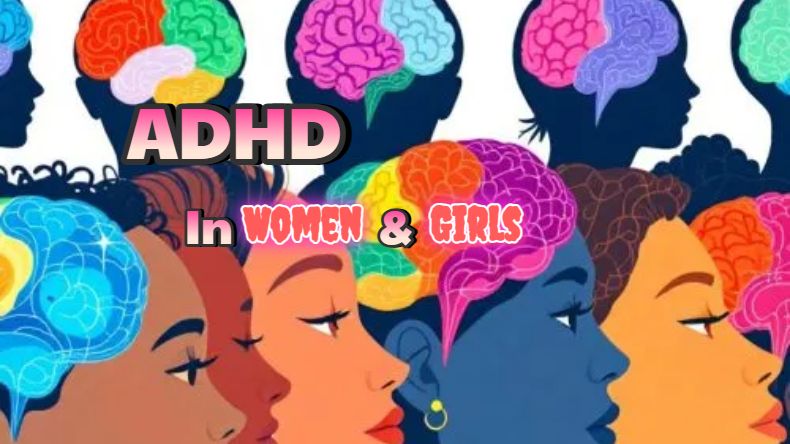
ADHD in Women and Girls: Unmasking the Hidden Neurodiversity
In a society that demands women to be "flawless", females with ADHD (Attention-Deficit/Hyperactivity Disorder) often find themselves trapped in an "invisible struggle".

Their symptoms are frequently misinterpreted as "carelessness", "emotional instability", or "lack of responsibility", while the underlying neurodevelopmental differences remain overlooked. Recent research indicates that the prevalence of ADHD in women is comparable to that in men, yet diagnostic rates are significantly lower, with many women receiving their diagnosis only in adulthood.
I. Misunderstood Symptoms: The Unique Manifestations in Females
Unlike the typical hyperactive-impulsive behaviors seen in males, females with ADHD more commonly exhibit inattentive-type symptoms. They may appear quiet in classrooms while their minds race with unstructured thoughts, failing to grasp teachers' instructions; in workplaces, they might be labeled "procrastinators" due to frequent missed details or difficulty initiating tasks. This "internal chaos" is often misread as character flaws rather than neurodevelopmental challenges.
1. Invisible Barriers in Executive Functioning
Organizational skills, time management, and emotional regulation pose the most persistent challenges for females with ADHD. Their repeated loss of keys or wallets, or chronic lateness to important events—these behaviors stem not from intent but from inherent deficits in the brain's processing of "working memory" and "priority sequencing". Studies reveal that executive dysfunction in women with ADHD correlates strongly with estrogen fluctuations, with symptoms often worsening during menstrual cycles, pregnancy, or menopause.
2. The Vicious Cycle of Internalized Symptoms
Prolonged self-doubt and external criticism make females with ADHD more susceptible to anxiety and depression. They may mask symptoms through "overcompensation"—pulling all-nighters to complete work or engaging in compulsive tidying—yet such exhaustive efforts often culminate in emotional burnout. Statistics show that women with ADHD are 3 times more likely to develop anxiety disorders and 4 times more prone to depression compared to the general population.
II. Diagnostic Dilemmas: Why Girls Are More Likely to Be Overlooked
1. Gender Bias in Medical Research
ADHD diagnostic criteria have long been based on male samples. For instance, 79% of participants in DSM-IV studies were male, leading to criteria that prioritize hyperactive-impulsive symptoms while neglecting inattentive presentations common in females. This bias results in girls being diagnosed 2-3 years later than boys, with many remaining undiagnosed until adulthood.
2. The Double Bind of Sociocultural Expectations
Societal expectations of women as "quiet and compliant" normalize ADHD symptoms. A daydreaming girl might be scolded for "not paying attention", whereas a boy exhibiting the same behavior is more likely to be evaluated for ADHD. More insidiously, girls are socialized to "mask" their true selves—they may mimic others' behavioral patterns to fit in, but this "camouflaging" exacerbates mental exhaustion.
3. The Interference of Comorbid Conditions
ADHD is frequently missed when anxiety, depression, or other emotional issues become the primary presenting symptoms. For example, a woman might receive a depression diagnosis for chronic insomnia and mood swings, while the root cause remains unrecognized ADHD. Research indicates over 60% of women with ADHD were misdiagnosed with other mental health conditions prior to their correct diagnosis.
III. Pathways to Change: From Diagnosis to Life Management
1. Keys to Accurate Diagnosis
Adult female ADHD diagnosis requires retrospective assessment of childhood symptoms: frequent loss of school supplies, homework struggles, or adolescent time-management difficulties. Professional evaluations should combine rating scales (e.g., ASRS-v1.1) and structured interviews (e.g., DIVA), while ruling out comorbidities. Self-assessment tools (such as free guides on Women & ADHD websites) can aid initial screening, but formal diagnosis requires medical professionals.
2. Personalized Treatment Approaches
-
Pharmacotherapy: Methylphenidate or atomoxetine effectively improve attention but require dosage adjustments according to hormonal cycles—some women may need temporary increases premenstrually.
-
Psychological Interventions: Cognitive Behavioral Therapy (CBT) helps reframe thought patterns (e.g., transforming "I'm a failure" to "My brain needs different strategies"). Mindfulness training alleviates anxiety and emotional lability.
-
Practical Skill Development: Using timers for task segmentation, establishing consistent organizational systems, and breaking goals into actionable steps significantly enhance quality of life.
3. Building Support Networks
Females with ADHD require multidimensional support from families, workplaces, and communities. Partners can share organizational responsibilities; schools might provide extended exam times or preferential seating. Support groups (like Women & ADHD communities) offer safe spaces for strategy-sharing and emotional validation.
IV. Debunking Myths: ADHD as Neurodifference, Not Deficit
Many women experience "cognitive restructuring" after diagnosis, recognizing that traits once deemed flaws—heightened creativity, enthusiasm for novelty, acute intuition—are expressions of neurodiversity. A designer might create unique work through ADHD's divergent thinking; an entrepreneur might seize opportunities via heightened risk tolerance.
Societal understanding of ADHD is evolving, but progress continues. From revising diagnostic criteria to advancing neurodiversity education, from reducing stigma to implementing inclusive support, we must cultivate environments where women with ADHD thrive as their authentic selves. As Michelle Frank writes in A Radical Guide for Women with ADHD: "Your brain isn't broken—it's wired differently—and that difference is your superpower".
Conclusion
The narratives of women with ADHD represent epics of resilience and awakening. They seek self-understanding amid misunderstanding, navigate solutions through adversity, and ultimately learn to reconcile with their neurodivergent brains. When society truly comprehends and embraces this diversity, we will witness more women shining uniquely—not despite ADHD, but by learning to dance with it.